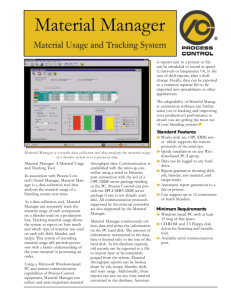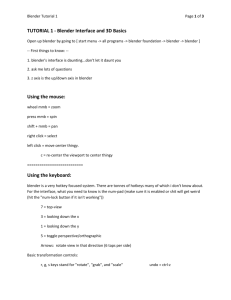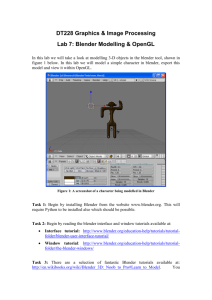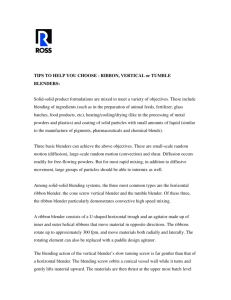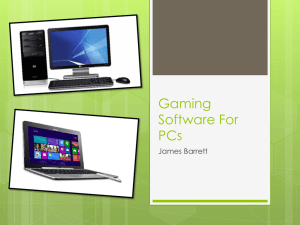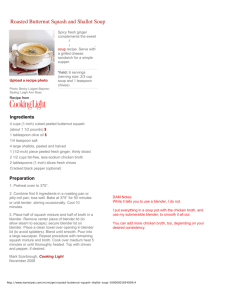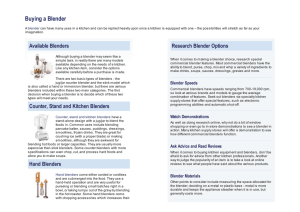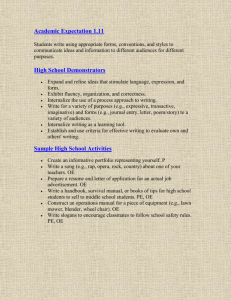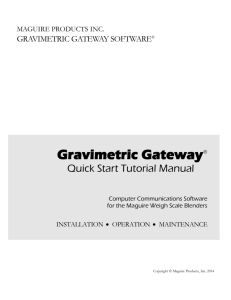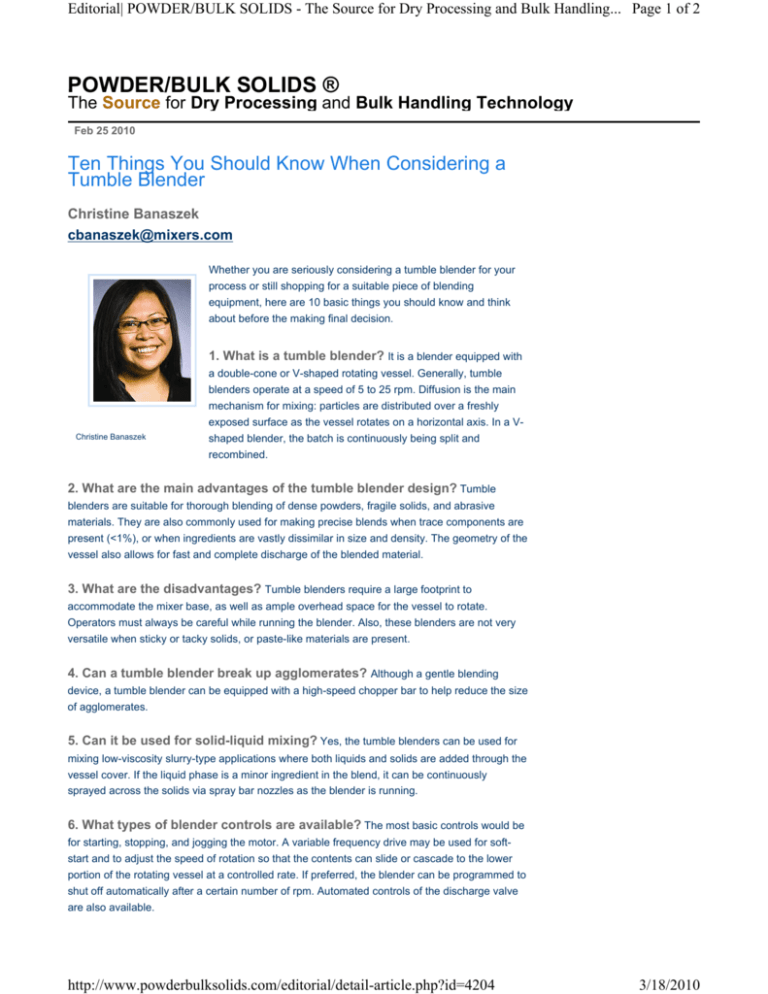
Editorial| POWDER/BULK SOLIDS - The Source for Dry Processing and Bulk Handling... Page 1 of 2
.POWDER/BULK SOLIDS ®
The Source for Dry Processing and Bulk Handling Technology
Feb 25 2010
Ten Things You Should Know When Considering a
Tumble Blender
Christine Banaszek
cbanaszek@mixers.com
Whether you are seriously considering a tumble blender for your
process or still shopping for a suitable piece of blending
equipment, here are 10 basic things you should know and think
about before the making final decision.
1. What is a tumble blender? It is a blender equipped with
a double-cone or V-shaped rotating vessel. Generally, tumble
blenders operate at a speed of 5 to 25 rpm. Diffusion is the main
mechanism for mixing: particles are distributed over a freshly
exposed surface as the vessel rotates on a horizontal axis. In a VChristine Banaszek
shaped blender, the batch is continuously being split and
recombined.
2. What are the main advantages of the tumble blender design? Tumble
blenders are suitable for thorough blending of dense powders, fragile solids, and abrasive
materials. They are also commonly used for making precise blends when trace components are
present (<1%), or when ingredients are vastly dissimilar in size and density. The geometry of the
vessel also allows for fast and complete discharge of the blended material.
3. What are the disadvantages? Tumble blenders require a large footprint to
accommodate the mixer base, as well as ample overhead space for the vessel to rotate.
Operators must always be careful while running the blender. Also, these blenders are not very
versatile when sticky or tacky solids, or paste-like materials are present.
4. Can a tumble blender break up agglomerates? Although a gentle blending
device, a tumble blender can be equipped with a high-speed chopper bar to help reduce the size
of agglomerates.
5. Can it be used for solid-liquid mixing? Yes, the tumble blenders can be used for
mixing low-viscosity slurry-type applications where both liquids and solids are added through the
vessel cover. If the liquid phase is a minor ingredient in the blend, it can be continuously
sprayed across the solids via spray bar nozzles as the blender is running.
6. What types of blender controls are available? The most basic controls would be
for starting, stopping, and jogging the motor. A variable frequency drive may be used for softstart and to adjust the speed of rotation so that the contents can slide or cascade to the lower
portion of the rotating vessel at a controlled rate. If preferred, the blender can be programmed to
shut off automatically after a certain number of rpm. Automated controls of the discharge valve
are also available.
http://www.powderbulksolids.com/editorial/detail-article.php?id=4204
3/18/2010
Editorial| POWDER/BULK SOLIDS - The Source for Dry Processing and Bulk Handling... Page 2 of 2
7. What other factors can contribute to blend quality in a tumble blender?
Filling to the appropriate product level and the method of doing so can affect blend quality.
Generally, it is more beneficial to add raw materials in layers rather than side by side. Of course,
no matter what type of blender is employed, interactions between particles will affect blend
quality. For example, diffusion is restricted by cohesive forces among particles but once these
powders are mixed, they tend to remain so. On the other hand, free-flowing powders can de-mix
as readily as they mix. Hence, it is important to initially determine optimal blend
time by taking samples at timed intervals.
8. Is it possible to arrange a blending trial? Reputable equipment suppliers offer this
service. Use your own raw ingredients and simulate conditions as close to your actual process
as possible. Another option is to rent a unit on which you can perform unlimited blending trials in
the convenience of your own facility.
9. Is the tumble blender right for you? Mixing trials will help you determine this
quantitatively. If possible, test other potential candidates such as ribbon blenders and vertical
cone screw blenders. You can then compare results of the trials against capital costs, floor
space requirements, and cycle time.
10. Important data to discuss with your blender supplier. The most critical
parameters will be bulk density of the blended material, major and minor components, preferred
material of construction and surface finish, desired working volume, heating and cooling
requirements, motor enclosure rating, vacuum and pressure requirements, and type and size of
discharge valve.
When in the market for new equipment, one cannot go wrong with good old fashioned planning.
The above considerations provide at least a good starting point as you review your processing
needs carefully. Work with a trusted manufacturer that offers long-term experience and testing
resources.
Christine Banaszek is an application engineer at Charles Ross & Son Co., a
manufacturer
of specialty mixing and blending equipment (www.mixers.com). She received her
B.S. in Chemical Engineering from the University of the Philippines (UP) – Diliman.
© 2010 by Canon Communications. All Rights Reserved.
Accessibility | Terms of use | Disclaimer | Privacy policy | Design, xhtml , css by Azapi
http://www.powderbulksolids.com/editorial/detail-article.php?id=4204
3/18/2010

